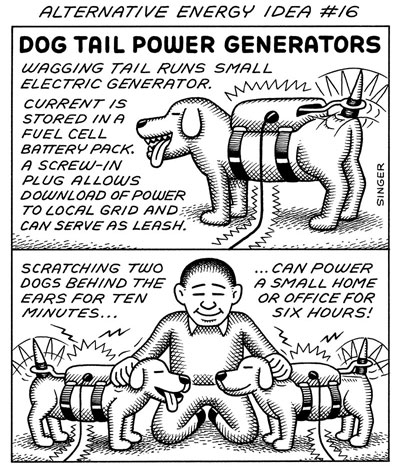sierraclub.org - sierra magazine - may/june 2011 - taking the initiative
By Carl Pope
WASHINGTON ON THE SERENGETI
Think of the Clean Air Act as a big cat, culling sick and aged power plants
 Andy Singer
Andy Singer
Animal Planet has taught us to imagine Africa's Serengeti Plain as a dramatic tableau, red in tooth and claw, in which predators and prey are implacable enemies. (That's how many American ranchers still see wolves and livestock.) But when you're actually there, it doesn't feel like that. Yes, the predators eat what they can get, including zebras, impalas, wildebeests, and the occasional buffalo.
But here's what happened when three cheetahs I was watching in the midst of a huge herd of zebras and wildebeests gave chase. The cats were fast, but the zebras bunched together into a galloping mass that almost encircled the cheetahs, which didn't dare plunge in. Eventually they tired and lay down under an acacia, while the herd resumed grazing only 20 yards away. It was the grazers that had stood their ground and that owned the Serengeti. The cheetahs' function was to pick off animals that were weak or sick; they were improving the herd, not threatening it.
You notice something similar when you look closely at the supposed antagonism of environmental protection and economic development. A Kenyan example: Driving into Nairobi from Kenyatta airport, you pass Uhuru Park—Nairobi's equivalent of New York's Central Park. This is where Nobel Peace Prize winner Wangari Maathai fought the Kenyan government's plan to build a huge commercial development—including a large statue of President Daniel arap Moi. In Kenyan eyes, Maathai wasn't so much protecting the environment as she was challenging corruption—making the Kenyan government more accountable and improving her country's ability to prosper.
Driving north from Nairobi, you pass a large area that was heavily forested until 20 years ago, when Moi gave it to the landless for clearing and settlement as an election day bribe. After a severe drought hit two years ago, the deforested, arid hills were no longer able to recharge the reservoirs behind the hydroelectric dams that power the economy. For Kenyans, forest protection isn't an amenity; it keeps the lights on and the factories open.
Most Africans—and a quarter of all humans—don't have access to electricity. Their societies can't afford to string wires from big power plants to distant huts. But isolated villages can be powered by biomass, wind, or the sun, which are cheaper than the candles and kerosene used today. India'sSelf-Employed Women's Association, one of the Sierra Club's partners abroad, has demonstrated that making solar-powered electric light available to poor families improves their kids' education. It also raises women's income, because when the sun goes down, they can still sew or make handicrafts. And unlike kerosene—which is generally imported—wind, sun, and biomass are local fuels, and making the equipment to harness them can jump-start local industries; such projects also quality for U.N. carbon credits. From the viewpoint of the family, it's straight economic development; from that of the women, a big step forward for social equality.
My point is that in these cases, as well as in many in the United States, it makes little sense to view the environment and the economy as enemies. Perhaps environmental protection is simply economic development with the accounting done properly and the time horizon extended a few years in the future. Perhaps we should view the Clean Air and Clean Water Acts the way the Masai see the predators on the Serengeti: as essential tools that improve future prosperity by culling unsustainable or outmoded practices—like burning coal to make electricity.
CARL POPE is the chairman of the Sierra Club. E-mail carl.pope@sierraclub.org; read his blog at sierraclub.org/carlpope.